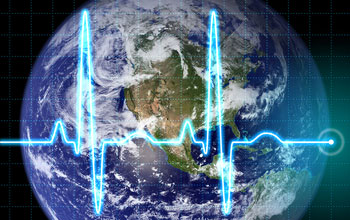 |
| NEON
will collect data that will enable scientists to-- for the first
time --measure the causes and long-term impacts of climate change,
invasive species and land use changes throughout the United States. In
addition, NEON will produce educational/outreach resources based on NEON
data. Credit: NASA and Thinkstock (design by National Science Foundation) |
| Download the high-resolution JPG version of the image. (786 KB) |
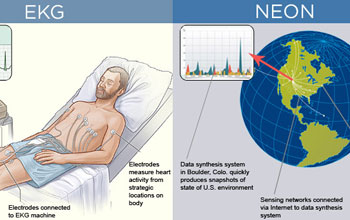 |
| Like an EKG, NEON will gather data from geographically dispersed, strategically located sensors. Credit: National Science Foundation |
Download the high-resolution JPG version of the image. (53 KB) |
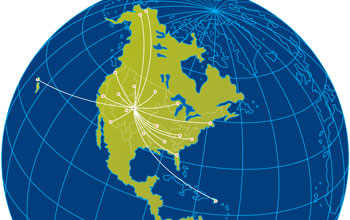 |
| NEON 's
106 data collection sites (60 terrestrial and 46 aquatic) have been
allocated among 20 distinct eco-climactic domains-- each of which is
distinguished by its vegetation, landforms, climate and ecosystem
performance. Additional NEON locations will be added, as appropriate, to
represent extreme conditions, such as droughts, fires and floods. Credit: NEON |
| Download the high-resolution JPG version of the image. (735 KB) |
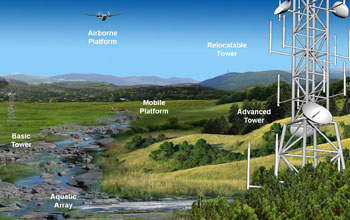 |
| At
each NEON location, ecological variables--such as pollution levels,
land use, diversity of plant and animal species, health and types of
vegetation, air temperature, and soil conditions--will be captured
through 539 unique measurements. Many of these measurements have never
before been collected in tandem to help identify long-term ecological
trends. Credit: CH2MHILL |
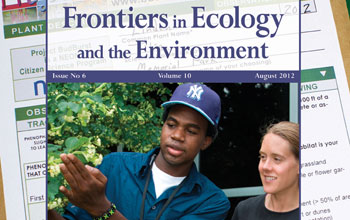 |
| Sandra
Henderson, the director of NEON 's Project BudBurst--a prominent
citizen science group--edited this special issue of "Frontiers" on
citizen science. Published in August 2012, it was the most popular
issue in the journal's history. Credit: Central photo:©C Calvin/University Corporation for Atmospheric Research. Background photo: © DL Ward/NEON |
Download the high-resolution JPG version of the image. (567 KB) |
| Use your mouse to right-click (Mac users may need to Ctrl-click) the
link above and choose the option that will save the file or target to
your computer. |
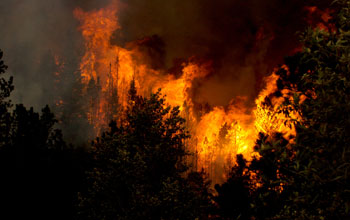 |
| The
High Park wildfire, which burned in the mountains near Fort Collins,
Colo., was started by lightning on June 9, 2012; it raged out of control
for weeks. A joint NEON/Colorado State University study of the fire s
entire huge burn scar and adjacent areas will provide critical data to
communities that are still coping with post-fire issues involving water
quality, erosion and ecosystem restoration. Credit: Colorado National Guard |
Reports of mounting ecological problems caused by climate change,
invasive species and land use changes invariably beg the question: What
is the current and future state of Earth's ecology?
Answers to
this question have traditionally been inadequate because scientists have
lacked a mechanism to systematically measure the long-term health of
large ecosystems. But that is now changing as a new, precedent-setting,
nationwide, multidisciplinary infrastructure-)--is starting to go online across the United
States.
What NEON will do
NEON will be to
ecological health what an EKG is to heart health. Like an EKG generates
snapshots of heart health by measuring heart activity from strategic
locations on a patient's body, NEON will generate snapshots of ecosystem
health by measuring ecological activity from strategic locations
throughout the United States.
At each NEON location, ecological
variables--such as pollution levels, land use, diversity of plant and
animal species, health of vegetation, soil conditions and air
temperature and humidity--will be captured through 539 unique
measurements, which will be recorded through calibrated instruments.
Many of these measurements have never before been collected in tandem to
help identify long-term ecological trends.
Because of its
standardized design, data produced by NEON will enable the scientific
community to generate the first apples-to-apples comparisons of
ecosystem health throughout the United States over multiple decades.
With
a coordinated, linked and integrated structure, NEON will be a single
national observatory, rather than a collection of regional
observatories. It will be the world's first observatory to listen to the
pulse of a continental ecosystem over multiple decades.
The timetable for NEON
Some
of NEON's data collection and educational operations have already
begun, and others will begin incrementally until NEON becomes fully
functional in 2017. Funded by the National Science Foundation (NSF),
NEON will be fully operational for some 30 years.
During NEON's
lifetime, tens of thousands of researchers, students of all levels,
educators, resource managers, decision-makers, policy experts,
government organizations and members of the public will use its
resources.
Recent accomplishments
NEON's
recent accomplishments include an ongoing, precedent-setting study of
the ecological impacts of the huge High Park Wildfire of Colorado in
2012, which is being jointly conducted with Colorado State University.
In addition, NEON's Project BudBurst--a nationwide citizen science
group--has, since 2010, been collecting information on plants that may
help scientists identify some impacts of climate change.
New NEON resources
More information about NEON is provided in the following multimedia resources:
- A quick overview video entitled, NEON at a Glance.
- An episode of Science Nation--a weekly series of short, mini documentaries on NSF-funded research--devoted to NEON.
- A brochure titled, National Ecological Observatory Network: Revolutionizing Ecological Research.
- A webcast on NEON with three experts: 1) Elizabeth Blood, NSF's program director for NEON; 2) Dave Tazik, NEON's director of biology; and 3) Tom Kampe, NEON's assistant director for remote sensing.
| -- | Lily Whiteman, National Science Foundation (703) 292-8310 lwhitema@nsf.gov |
Investigators
Russ Lea
David Schimel
Anthony Beasley
Larrabee Winter
David Schimel
Anthony Beasley
Larrabee Winter
Related Institutions/Organizations
National Ecological Observatory Network, Inc
Related Awards
#1138160 Construction and Operations of the National Ecological Observatory
#1029808 Cooperative Support Agreement for Major Research Equipment and Facilities Construction (MREFC) of the National Ecological Observatory
#1029808 Cooperative Support Agreement for Major Research Equipment and Facilities Construction (MREFC) of the National Ecological Observatory
Total Grants
$112,629,319
Related Websites
NEON's webite:
NEON's webite:
http://www.neoninc.org
NSF article about NEON's use by Native Americans:
NSF article about NEON's use by Native Americans:
http://www.nsf.gov/discoveries/disc_summ.jsp?cntn_id=127232
Webcast on NEON's Project BudBurst and other citizen science groups:
Webcast on NEON's Project BudBurst and other citizen science groups:
http://www.nsf.gov/news/news_summ.jsp?cntn_id=124991
NEON's Project Budburst:
NEON's Project Budburst:
http://budburst.org
NSF press release on NEON:
Guillermo Gonzalo Sánchez AchuteguiNSF press release on NEON:
ayabaca@yahoo.com
ayabaca@hotmail.com
ayabaca@gmail.com
No hay comentarios:
Publicar un comentario